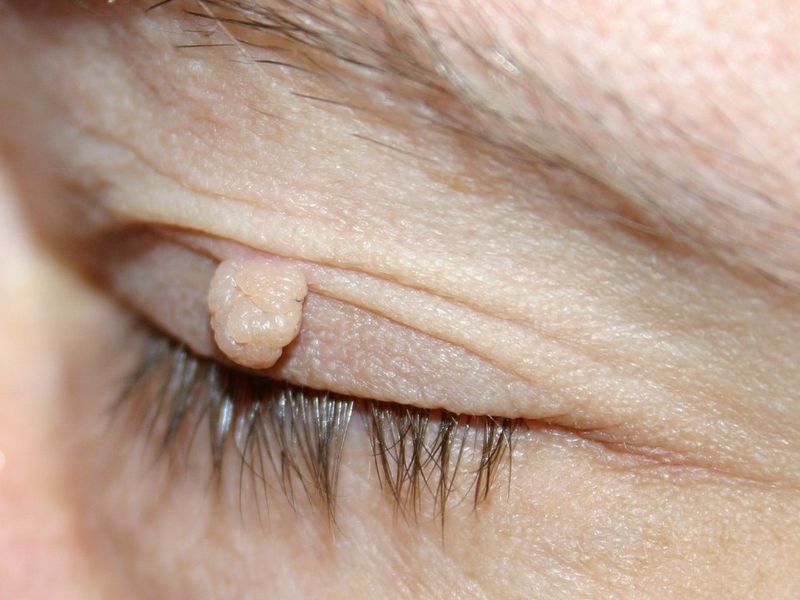Fibroma
| Fibroma | |
 | |
|---|---|
| Soft Fibroma (fibroma molle). | |
| ICD-O: | 8810/0 |
| MeSH | D005350 |
|
WikiDoc Resources for Fibroma |
|
Articles |
|---|
|
Most recent articles on Fibroma |
|
Media |
|
Evidence Based Medicine |
|
Clinical Trials |
|
Ongoing Trials on Fibroma at Clinical Trials.gov Clinical Trials on Fibroma at Google
|
|
Guidelines / Policies / Govt |
|
US National Guidelines Clearinghouse on Fibroma
|
|
Books |
|
News |
|
Commentary |
|
Definitions |
|
Patient Resources / Community |
|
Directions to Hospitals Treating Fibroma Risk calculators and risk factors for Fibroma
|
|
Healthcare Provider Resources |
|
Causes & Risk Factors for Fibroma |
|
Continuing Medical Education (CME) |
|
International |
|
|
|
Business |
|
Experimental / Informatics |
Editor-In-Chief: C. Michael Gibson, M.S., M.D. [1]
Overview
Fibromas (or fibroid tumors or fibroids) are benign tumors that are composed of fibrous or connective tissue. They can grow in all organs, arising from mesenchyme tissue.
The term "fibroblastic" or "fibromatous" is used to describe tumors of the fibrous connective tissue. When the term fibroma is used without modifier, it is usually considered benign, with the term fibrosarcoma reserved for malignant tumors.
The term fibroid can also refer to tumors of smooth muscle, as in uterine fibroids.
Hard Fibroma
The hard fibroma (fibroma durum) consists of many fibres and few cells, e.g. in skin it is called dermatofibroma (fibroma simplex or nodulus cutaneous), might A special form is the keloid, which derives from hyperplastic growth of scars.
Soft Fibroma
The soft fibroma (fibroma molle) or fibroma with a shaft (acrochordon, skin tag, fibroma pendulans) consist of many loosely connected cells and less fibroid tissue. It mostly appears at the neck, armpits or groins. The photo shows a soft fibroma of the eyelid.
Other Types of Fibroma
The fibroma cavernosum or angiofibroma, consists of many often dilated vessels, it is a vasoactive tumor occurring almost exclusively in adolescent males.
The cystic fibroma (fibroma cysticum) has central softening or dilated lymphatic vessels.
The myxofibroma (fibroma myxomatodes) is produced by liquefaction of the underlying soft tissue.
The cemento-ossifying fibroma is hard and fibrous, most frequently seen in the jaw or mouth, sometimes in connection with a fracture or another type of injury.
Other fibromas: chondromyxoid fibroma, desmoplasmic fibroma, nonossifying fibroma, ossifying fibroma, perifollicular fibroma, pleomorphic fibroma etc.
Ovarian Fibroma
It appears in the sex cord-stromal tumour group of ovarian neoplasms. Ovary fibromas are most frequent during middle age, and rare in children. Upon gross pathological inspection, ovary fibromas are firm and white or tan. Variants with edema are especially likely to be associated with Meig's syndrome. On microscopic examination, there are intersecting bundles of spindle cells producing collagen. There may be thecomatous areas (fibrothecoma).
Treatment
Benign fibromas can be removed or left alone. A physician should examine the fibroma and determine whether it may be malignant. If there is any question as to whether it may be cancer-related, it should be removed. This is usually a brief outpatient procedure.
Outcomes
See also
- Peripheral ossifying fibroma
- Acrochordon (skin tags)
External links
da:Fibrom de:Fibrom it:Fibromioma uterino